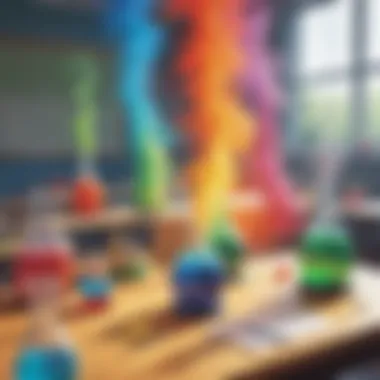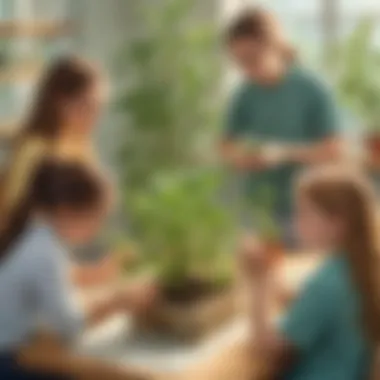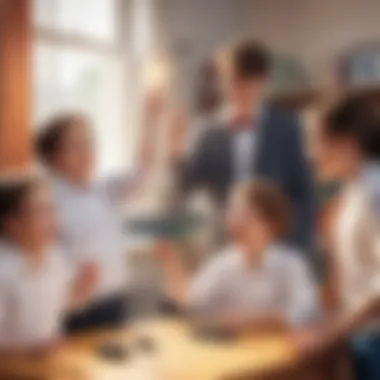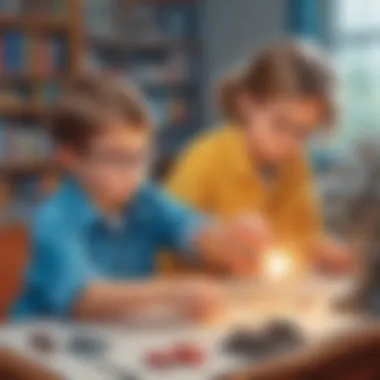Engaging Science Experiments for Young Learners


Intro
In today’s learning environment, experiments serve as a pathway to curiosity, engaging young minds in science. This article unravels a series of easy and exciting experiments that can be conducted in a classroom setting. The focus is on simplicity and safety, aimed primarily at children aged 6 to 12. These experiments not only boost understanding of basic scientific concepts but also foster a cumulative experience of exploration. By utilizing everyday materials, students can creatively interact with science, which provides both fun and educational outcomes.
Science Fun Facts
Science is full of surprises! Let's explore some intriguing facts that set the stage for excitement in scientific discovery.
Interesting Trivia and Facts
- Water Expands When It Freezes: Unlike most liquids, water increases in volume when it transitions to ice. This is a crucial concept that explains why ice floats on water.
- Honey Never Spoils: Archaeologists have discovered pots of honey in ancient Egyptian tombs that are over 3,000 years old. They are still safe to eat!
- Bananas are Berries: Botanically speaking, bananas qualify as berries, while strawberries do not. This flips common beliefs on their heads.
Quirky Science Stories
One day, a group of researchers wanted to understand why some species of frogs change color. What they discovered was unexpected—these color adaptations help them blend in with their environments to avoid predators.
Amazing Science Records
- The Largest Snowflakes Ever Recorded: In 1887, a snowflake measuring 15 inches wide fell in Fort Keogh, Montana.
- Loudest Noise Ever Recorded: The 1883 eruption of Krakatoa generated a sound that could be heard over 3,000 miles away!
Thought-Provoking Questions
- Why does the sky appear blue during the day but red at sunset?
- What makes sound travel faster in water than in air?
Curiosity leads to exploration, so these questions can stimulate discussions among young learners and help them delve into scientific inquiries.
Discover the Wonders of Science
Understanding scientific concepts lays the groundwork for educational success. Exploring these ideas in a classroom cultivates excitement and deeper comprehension.
Exploring Various Scientific Concepts
From physics to biology, each science discipline offers unique experiments. This may include exploring chemical reactions with baking soda and vinegar or investigating the properties of magnets.
Educational Videos and Animations
Using videos is an effective strategy to enhance comprehension. Websites like Britannica feature videos that explain experiments visually.
Interactive Learning Tools
Young learners benefit from apps and interactive platforms that reinforce hands-on learning. Resources like Reddit have forums where instructors share ideas for engaging experiments.
Real-Life Applications of Science
Discussing how scientific concepts apply in daily life encourages practical understanding. Simple phenomena—like rainbows forming after rain—allow students to see science outside the classroom.
Science Quiz Time
After exploring these concepts, it is beneficial to reinforce knowledge through quizzes.
Interactive Quizzes
Quizzes can take various forms, such as online setups or printed handouts, featuring multiple-choice or fill-in-the-blank questions.
Multiple Choice Questions
- What natural phenomenon can be created with a glass of water and a flashlight? (A) Rainbow (B) Earthquake
Brain Teasers and Puzzles
Using these teasers challenges the mind while linking back to scientific principles effectively.
Learning Through Gamification
Inquisitive minds thrive through gamified learning approaches, making education feel less like work and more like play.
Science Experiment Showcase
Experiments are the key to fostering curiosity. Here's a broad look into engaging science experiments that ignite a passion for knowledge.
Fun and Engaging Experiments


Students can easily conduct experiments using household items, forging a connection between theory and practical application.
Step-by-Step Instructions
An experiment should have clear guidelines. For example, for the classic “volcano effect” with baking soda and vinegar, follow these instructions:
- Pour vinegar into a container.
- Add food coloring (if desired).
- Mix in baking soda rapidly and watch it overflow like a erupting volcano.
Materials List
Common materials can include vinegar, baking soda, balloons, and plates.
Safety Tips and Precautions
Always encourage safety practice, such as wearing goggles or gloves when needed, to ensure an enjoyable experience without harm.
Encouraging students to be hand-on will captivate their interest and spark a genuine passion for science. This comprehensive guide combines knowledge, fun, and safety, presenting science as a captivating adventure.
Prelims to Classroom Experiments
Classroom experiments serve as an essential component of elementary science education. They allow students not just to observe concepts but to actively engage with them. This synthesis of theory and practice enhances learning retention and fosters curiosity among young learners. By involving students in hands-on activities, educators create an environment that encourages inquiry and exploration.
For educators, it is vital to understand the importance that these experiments hold for developing inquiry skills and scientific knowledge. When students perform experiments, they do not just collect data; they also learn to ask meaningful questions. This process empowers them to think like scientists, shaping a mindset that values exploration and problem-solving. In educational settings, recognizing the significance of engaging activities can boost both individual and group interest.
Moreover, classroom experiments cater to various learning styles. Visual learners can see the principles in action, while kinesthetic learners benefit from the tactile experiences. Through experimentation, young minds intuitively connect concepts, broadening their understanding of the world. This multidimensional learning style supports a comprehensive educational experience, pushing students beyond rote memorization.
Beyond gaining knowledge, hands-on experiments are enjoyable and can contribute to positive classroom dynamics. The collaborative nature of experiments encourages teamwork, further enhancing social skills important for personal development. Overall, focusing on classroom experiments yields educational and emotional benefits.
The Importance of Hands-On Learning
Hands-on learning is paramount in a child's educational journey. This active approach transforms passive learning into a dynamic encounter with knowledge. Children remember better when they physically manipulate materials and observe outcomes. With simple experiments, learners delve deeper into scientific concepts as they can practically apply theories. They gain immediate feedback, fostering a sense of discovery and excitement.
Experimentation also bridges the gap between classroom knowledge and real-world applications. It allows children to relate what they learn to daily life, making understanding more concrete. This continuous cycle of action, observation, and reflection develops critical thinking skills necessary for science.
Supporting hands-on learning shifts the traditional teaching paradigm. Educators fostering a workshop classroom style promote initiative and resilience. As those young learners encounter both successes and failures during experiments, they build an intrinsic motivation toward tackling challenges. Such experiences should be central to effective science curriculums.
Objectives of Simple Experiments
Simple experiments in the classroom address key objectives. Primarily, they aim to spark curiosity in young learners. When children become genuinely interested in a topic, they engage more fully in their education. The second objective involves enhancing comprehension. These activities present concepts in an accessible format, breaking down complex information into manageable tasks.
A third crucial objective is the development of scientific skills. Those include making observations, forming hypotheses, and conducting investigations. Becoming adept at these skills builds a foundation average future scientists will need.
There is also an emphasis on fostering teamwork among peers. Many simple experiments require collaborative efforts, allowing students to communicate effectively while working towards a shared goal. This aspect of group work invites a sense of responsibility and leadership, vital in future educational and professional settings.
By focusing on objectives, educators can intentionally guide students toward a holistic understanding of science and its applications.
Preparation for Conducting Experiments
Preparing for classroom experiments is a critical step in making scientific activities successful, especially for young learners. Effective preparation lays the groundwork for a smooth and informative experience. When educators are organized and intentional about their setup, students can focus on learning rather than managing logistics or uncertainties during the experiment.
Gathering Materials
One of the first steps in preparation is gathering the right materials for each experiment. Having the necessary items ensures that lessons proceed without unnecessary interruptions. List the materials for each experiment clearly. Here are some guidelines:
- Plan Ahead: Before the class begins, check the materials list for each experiment. Ensure all required items are on hand.
- Quality Control: Use quality materials for experiments. If students can see and touch good quality items, they are more likely to engage positively.
- Efficient Shopping: Consider outlets such as local stores or online resources. Many materials might be readily available in exchange for little preparation time.
- Involve Students: Allow students to participate in gathering materials. This can foster responsibility and foster teamwork amongst classmates.
As any teacher knows, sometimes experiments use everyday items. For instance, when creating crystals or slime, simple household products can become valuable teachable moments. Be creative yet cautious with this.
Organizing the Space
An organized space is essential for conducting experiments effectively. Students benefit from having a well-organized environment. Consider these logistical tips to ensure the workspace is suitable:
- Assign Workstations: Create designated areas for experiments. This helps students stay focused and understand where to find their necessary equipment.
- Clear Obstructions: Make sure paths to all materials are clear. This minimizes distractions and maintains momentum during experiments.
- Designate Safety Areas: Specify parts of the room where certain experiments can take place safely. Define rules to ensure that students understand and respect these limits.
- Prepare Cleaning Supplies: Have materials for clean-up within easy reach. This encourages prompt maintaining of the surrounding area after each session, promoting responsibility.
Safety Considerations
Maintaining a safe experiment environment is foremost when preparing for classroom activities. Understanding the risks is vital for every experiment. Here are critical safety tips:
- Read Instructions Carefully: Each experiment may have hidden dangers or concerns, such as exposure to certain chemicals. Being informed prevents accidents before they happen.
- Always Use Protective Gear: Encourage students to wear goggles or gloves when dealing with chemicals or sharp objects. It teaches them to respect the materials.
- Step-by-Step Overviews: Provide students with guidelines before starting. Help them know what to expect at each stage while addressing potential hazards in context.
- Emergency Protocols: Make sure that students know the proper steps to take in an emergency event. Discuss exits and what to do with spillage, though it should not be common occurrences directly caused by experiments.
Preparation combines organization with a respect for safely exemptions within the consult. Schools can cultivate interest in science with right setups while raising interest among students. Preparing adequately sets a solid foundation and expectations, enriching educational experiences aligned with student curiosity.


List of Easy Experiments
Experiments conducted in the classroom serve an essential purpose. They allow young science enthusiasts to engage with concepts directly, making abstract ideas tangible. Such experiments not only boost critical thinking but also nurtures problem-solving skills among students. Choosing the right experiments can inspire curiosity and foster a love for learning.
Growing Crystals
Materials Needed
The success of growing crystals relies on the choice of materials. Commonly used items include table salt, sugar, or Epsom salt. These substances effectively form visual representations of crystal growth, which is fundamental for young learners. Their simple availability makes them ideal for classrooms.
Step-by-Step Instructions
Instruction clarity is highly crucial in this experiment. Following straightforward steps ensures students comprehend every phase involved in the crystal formation process. A well-defined guide also enhances engagement by allowing learners to see real-time progress. This celebrates both patience and perseverance.
Expected Outcomes
Anticipating outcomes is key to understanding the scientific process. Students should expect to see clear, defined crystals emerge after a few days. Observing these results enables discussions about concepts like saturation and crystallization—a beneficial learning aspect in any curriculum.
Building a Simple Volcano
Materials Needed
For building a volcano, commonly found materials come into play. Baking soda, vinegar, and food coloring are iconic choices. Their established accessibility paves the way for a seamless experiment. As students mix, they visually witness reactions, which offers immediate feedback and understanding.
Procedure
Detailing the procedure helps guide students through the experience of erupting volcanoes. Vivid and exciting observations can lead to deeper inquiries about chemical reactions and natural disasters. The excitement of the experiment makes it both memorable and educational for students.
Scientific Explanation
Relating the experiment to real-world phenomena anchors theoretical knowledge. Students learn about exothermic reactions and how gases expand. Dedicating time to discussing the science behind the excitement ensures that the fun only leads to enhanced comprehension of fundamental concepts.
Creating a Homemade Barometer
Required Items
Collecting items like a balloon, a jar, and a straw is necessary for crafting a barometer. These are normal household items that students can easily find, promoting an at-home continuation of their learning. This familiar ground aids in thorough understanding.
How to Assemble
The assembly process is an enlightening experience. Following the steps helps students grasp the principles of measuring atmospheric pressure. It also encourages them to engage directly with physics and meteorology, bridging curriculum gaps in a meaningful way.
Understanding Weather Patterns
This experiment brings home how atmospheric conditions affect local weather. Young learners can connect this discussion to daily changes, developing a personal interest in environmental science. Recognizing the patterns should empower them to care about sustainability and changes in our ecosystem.
Making Slime
Ingredients List
Gathering common ingredients such as glue, baking soda, and contact lens solution forms the basis of this enjoyable activity. Their abundance in arts and crafts settings makes slime creation a favored experiment among students. Kids often feel excitement about creating something they can also play with later.
Mixing Instructions
Clear mixing instructions make this thrilling experience accessible. Showing appropriate measurements and techniques encourages precise following and teamwork. This exercise develops cooperation among students while nurturing creativity.
Properties of Materials
Discussing the physical characteristics of slime opens conversations about polymers and gels. Families of substances students learn about here apply broadly in chemistry. This discussion arms kids with knowledge that shapes understanding in everyday contexts like food science.
Simple Water Filtration
Essential Supplies
Essential supplies for a water filtration project break down into found materials: sand, charcoal, cotton, and a plastic bottle. Their lack of overly technical nature assists in grounding student understanding of water safety. Also, financial accessibility makes this education valuable at all education levels.
Step-by-Step Filtering Process
When explaining the filtering steps, clarity is paramount. Engaging discussions about the effectiveness of each material allows for data analysis reporting, critical in scientific pursuits. Witnessing impurities being removed is exciting for children.
Discussion on Clean Water


Addressing the importance of clean water creates a meaningful broader dialogue. Students can better appreciate environmental conservation efforts while understanding scientific elements necessary to keep ecosystems viable and communities safe. This topic leaves a lasting impression on developing young minds.
Classroom Management Tips
Classroom management is critical for the success of any science experiment. When students engage in hands-on activities, their excitement can lead to distractions if not properly managed. Keeping control over the classroom ensures a safe environment as well as fosters an atmosphere conducive to learning. This section will elaborate on methods to effectively engage students, manage time during experiments, and facilitate group work.
Engaging Students
Engaging students is vital in ensuring they absorb and understand the material presented in experiments. To capture their interest, you may consider using open-ended questions related to the activity. This approach encourages students to think creatively and express their ideas, fostering a connection to the material.
- Relate Experiments to Real Life: Connecting theoretical concepts to real-world applications can enhance students’ curiosity. For example, explaining the basics of chemical reactions through everyday cooking shows relevance.
- Utilize Technology: Incorporating technology, like presentation software or educational videos, can grab attention. Platforms like YouTube can offer visual explanations of scientific phenomena.
- Interactive Demonstrations: Direct participation keeps students focused. Get them involved through demonstrations. Hands-on engagement stimulates their desire to learn and explore further.
Time Management Strategies
Proper time management can improve the effectiveness of classroom experiments. When students feel rushed, they may not fully grasp the concepts. Establishing a clear time frame for each part of the experiment helps maintain consistency.
- Outline Steps Clearly: Break the experiment into simple, logical steps. Presenting this in a visual format helps students follow along without confusion.
- Use Timers: Employing a timer can create a sense of urgency while also allowing students to pace themselves. Setting clear time intervals for each task and using countdowns can increase focus.
- Plan for Transitions: Moving from one part of the experiment to another can sometimes take longer than expected. Be prepared for these transitions and allow extra time in your schedule to avoid overwhelming students.
Facilitating Group Work
Group work stands at the core of many classroom experiments. Working in teams promotes collaboration and communication skills. However, effective facilitation of group work is essential for achieving the desired learning outcomes.
- Define Roles Clearly: Assign specific roles within each group, such as leader, note-taker, and reporter. This creates a structured environment where everyone's responsibilities are understood.
- Encourage Collaboration Over Competition: Focus on completing the experiment as a team instead of competing for the best results. This fosters a supportive environment in which students can learn from each other.
- Monitor Groups Regularly: Circulating around the room during the experiment goes a long way. This allows you to assess group dynamics and provide support or steer discussions in productive directions as needed.
Effective classroom management not only enhances the learning process, but also promotes smoother, more enjoyable experiments for students. The right environment makes science accessible and fun for young learners.
By integrating these classroom management tips, teachers can create a more effective learning environment where young science enthusiasts can thrive.
Evaluating Experiment Outcomes
Evaluating experiment outcomes is crucial in the educational environment. It not only helps educators gauge the effectiveness of the experiments but also fosters a deeper understanding of scientific concepts among students. Through evaluation, teachers can identify students’ strengths and weaknesses, refine their teaching methods, and enhance overall engagement with the material. Furthermore, precise assessments enable students to see the connection between theory and practice, which is vital for their scientific development.
Assessing Student Understanding
Assessing student understanding involves evaluating how well learners grasp the concepts presented through the experiments. This can be done using various methods such as quizzes, discussions, or simple observation during the experiments. Incorporating reflective questions can allow students to articulate their thought processes. For example, ask questions like, "What did you expect to happen in this experiment?" or "Why do you think the results turned out this way?" These questions prompt students to engage critically with their learning experience.
Tips for Effective Assessment:
- Keep assessments straightforward to ensure children can answer comfortably.
- Use both formative and summative methods to prepare students for future learning.
- Offer personalized feedback to help students understand their performance better.
Discussion of Results
Having discussions about the results is essential for synthesizing learning. It fosters an environment where students can share their findings, insights, and even disappointments. These conversations allow students to articulate their conclusions and compare them with their classmates. Group discussions not only cultivate communication skills but also expose students to different perspectives on the same experiment.
"Collaborative discussions deepen understanding and reinforce concepts learned during the experiments."
Teachers can moderate discussions, prompting students to elaborate on their results and connect them back to the scientific principles at play. Essential guiding questions include:
- What did you learn from the results?
- Did anything surprise you about your findings?
- How do the outcomes relate to real-world applications?
Encouraging Further Exploration
Encouraging further exploration is vital in nourishing a student's scientific curiosity. Once experiments conclude, teachers should guide students to take the next steps in their learning journey. This can be achieved by suggesting related experiments to deepen knowledge areas. For instance, after a water filtration experiment, students might explore different filtration materials or the science behind water contaminants specifically.
Strategies for Further Exploration:
- Introduce advanced online resources like the Wikipedia entry on chemistry experiments or articles on Britannica for older students.
- Set up science fairs where students can present findings and new ideas.
- Encourage collaborative projects that link classroom learnings to community issues.
Integrating evaluation with encouragement propels the journey of discovery. By enriching their understanding, fostering discussions, and kindling curiosity, teachers empower students to pursue science well beyond the classroom walls.
End
In this final section of the article, we will emphasize the values of classroom experiments discussed throughout. Conducting easy experiments can dramatically enhance the educational experience for young students. This hands-on approach not only teaches children vital scientific concepts but also fosters their curiosity and engagement. It is essential for educators and parents to recognize how these simple activities can transform learning from a passive task into an interactive exploration of the world.
Recap of Experiment Benefits
The benefits of engaging in easy experiments in the classroom are numerous:
- Active engagement: Children learn best when they are actively participating. Experiments make concepts tangible and easier to comprehend.
- Critical thinking: As students formulate hypotheses, conduct tests, and draw conclusions, they develop problem-solving skills.
- Collaboration: Working in groups strengthens social skills and fosters teamwork. Students learn to communicate effectively and share ideas.
- Application of knowledge: Implementing theoretical concepts in practical ways reinforces learning, making it more memorable.
- Safe exploration: Classroom experiments are designed to be safe, offering students a chance to explore without substantial risks.
"Experiments are a powerful way to stimulate young minds and illustrate abstract scientific ideas in a tangible manner."
Encouragement to Explore Science
Encouraging children to explore science beyond simple classroom experiments is crucial. Young science enthusiasts should feel motivated to questioning and investigating phenomena in their daily lives. Failure is often a part of the scientific process, and teaching children to regard setbacks as learning opportunities promotes resilience.
Parents and educators should support this curiosity by:
- Providing resources, such as books or videos that explain scientific concepts further.
- Encouraging out-of-class exploration like visiting science museums, nature walks, or local laboratories.
- Motivating students to pursue their interests in science projects that can be conducted at home.







